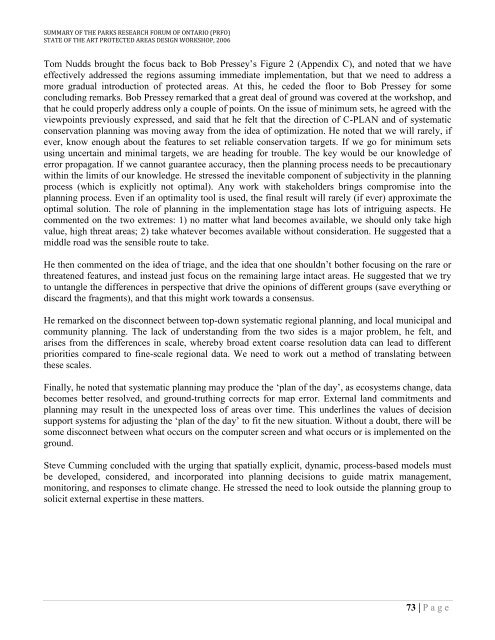Top-Down vs. Bottom Up: Working Towards Consensus ... - CASIOPA
Top-Down vs. Bottom Up: Working Towards Consensus ... - CASIOPA
Top-Down vs. Bottom Up: Working Towards Consensus ... - CASIOPA
- No tags were found...
Create successful ePaper yourself
Turn your PDF publications into a flip-book with our unique Google optimized e-Paper software.
SUMMARY OF THE PARKS RESEARCH FORUM OF ONTARIO (PRFO)STATE OF THE ART PROTECTED AREAS DESIGN WORKSHOP, 2006Tom Nudds brought the focus back to Bob Pressey‟s Figure 2 (Appendix C), and noted that we haveeffectively addressed the regions assuming immediate implementation, but that we need to address amore gradual introduction of protected areas. At this, he ceded the floor to Bob Pressey for someconcluding remarks. Bob Pressey remarked that a great deal of ground was covered at the workshop, andthat he could properly address only a couple of points. On the issue of minimum sets, he agreed with theviewpoints previously expressed, and said that he felt that the direction of C-PLAN and of systematicconservation planning was moving away from the idea of optimization. He noted that we will rarely, ifever, know enough about the features to set reliable conservation targets. If we go for minimum setsusing uncertain and minimal targets, we are heading for trouble. The key would be our knowledge oferror propagation. If we cannot guarantee accuracy, then the planning process needs to be precautionarywithin the limits of our knowledge. He stressed the inevitable component of subjectivity in the planningprocess (which is explicitly not optimal). Any work with stakeholders brings compromise into theplanning process. Even if an optimality tool is used, the final result will rarely (if ever) approximate theoptimal solution. The role of planning in the implementation stage has lots of intriguing aspects. Hecommented on the two extremes: 1) no matter what land becomes available, we should only take highvalue, high threat areas; 2) take whatever becomes available without consideration. He suggested that amiddle road was the sensible route to take.He then commented on the idea of triage, and the idea that one shouldn‟t bother focusing on the rare orthreatened features, and instead just focus on the remaining large intact areas. He suggested that we tryto untangle the differences in perspective that drive the opinions of different groups (save everything ordiscard the fragments), and that this might work towards a consensus.He remarked on the disconnect between top-down systematic regional planning, and local municipal andcommunity planning. The lack of understanding from the two sides is a major problem, he felt, andarises from the differences in scale, whereby broad extent coarse resolution data can lead to differentpriorities compared to fine-scale regional data. We need to work out a method of translating betweenthese scales.Finally, he noted that systematic planning may produce the „plan of the day‟, as ecosystems change, databecomes better resolved, and ground-truthing corrects for map error. External land commitments andplanning may result in the unexpected loss of areas over time. This underlines the values of decisionsupport systems for adjusting the „plan of the day‟ to fit the new situation. Without a doubt, there will besome disconnect between what occurs on the computer screen and what occurs or is implemented on theground.Steve Cumming concluded with the urging that spatially explicit, dynamic, process-based models mustbe developed, considered, and incorporated into planning decisions to guide matrix management,monitoring, and responses to climate change. He stressed the need to look outside the planning group tosolicit external expertise in these matters.73 | P a g e


